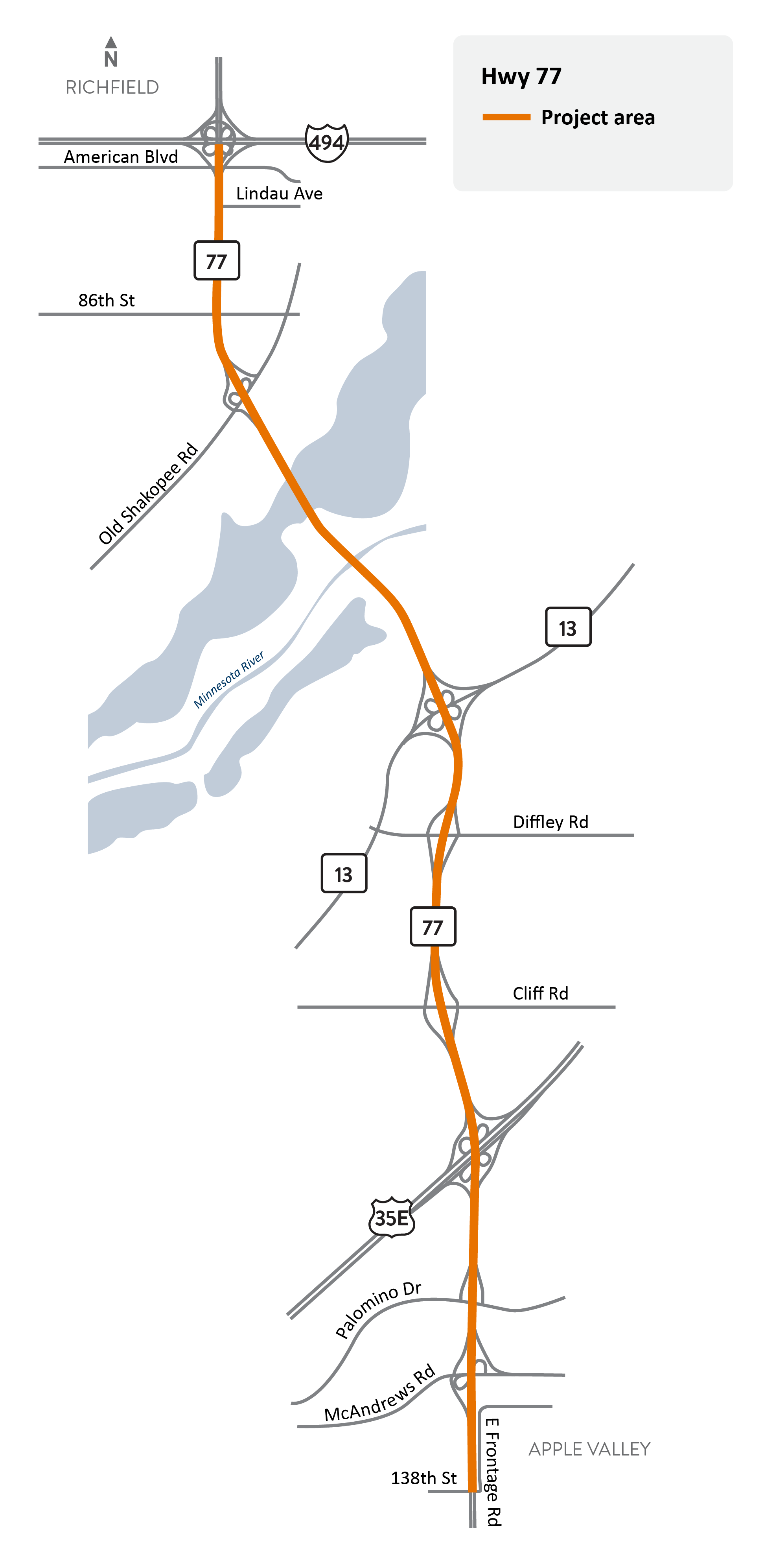Study complete
About this study

Hwy 77 project location map.
Click map for larger version.
The purpose of the study was to evaluate Hwy 77/Cedar Ave. between 138th St. in Apple Valley and I-494 in Bloomington to identify potential congestion mitigation concepts. The study was initiated in response to recurring congestion, crash history and reliability issues experienced along the corridor. The study was timed to provide for the possibility of incorporating some improvements into the pavement resurfacing project scheduled for 2026.
View the Hwy 77 Congestion Mitigation Study Executive Summary (PDF). The executive summary provides a list of technical reports that provide detailed documentation of analysis that makes up the Hwy 77 Congestion Mitigation Study. There reports are available by request.
Summary of work
- During the study the following transportation problems were identified.
Pavement conditions
- Pavement in the corridor is deteriorating.
- Conditions of the pavement range from “fair” to “good”.
- Will get worse faster without needed maintenance projects.
Vehicle mobility (pre-COVID)
- Traffic demand exceeds the capacity of the road.
- Drivers, buses and trucks experience delay and travel time is unreliable.
- Conditions will get worse in the future.
Pedestrian and bicycle crossings
- Hwy 77 is a barrier for walkers, bikers and bus users.
- Most crossings have sidewalks on at least one side.
- There are opportunities to make some crossings better.
Bridges
- There are 30 bridge structures in the Hwy 77 corridor from 138th St. to I-494.
- Three are older and nearing the end of their service life.
- Regular maintenance will continue to be needed.
The next step was to identify potential solutions to address the problems. During this phase, MnDOT identified alternatives for the entire corridor as well as alternatives that would improve partial areas of the corridor.
Full corridor alternatives
- General Purpose Light: Adds a third northbound lane in places where there are only two lanes today.
- Keeps current transit advantages.
- Reduces congestion south of the river but increases congestion north of the river.
- Lowest cost of the three Full Corridor options.
- General Purpose Add Lane: Adds a fourth regular lane to the entire corridor.
- Keeps current transit advantages.
- Reduces most congestion throughout the corridor but still has reliability issues.
- Mid-high cost of the three options.
- High Occupancy Toll (HOT) Lane Add Lane: Adds an E-ZPass lane to the entire corridor for use by buses carpools, motorcycles or people who choose to pay.
- E-ZPass lane during rush hour.
- Keeps current transit advantages.
- Reduces most congestion throughout the corridor but still has reliability issues.
- Mid-high cost of the three options.
Partial corridor alternatives
- General Purpose Ultra Light
- Adds a third lane northbound from 138th St. to McAndrews Rd.
- Four Lanes over the MN River
- Restripes Minnesota River Bridge to allow four travel lanes in each direction.
- Two Lanes Eastbound I-494 to Southbound 77
- Adds capacity to the connection from eastbound I-494 to southbound Hwy 77.
The final step in the study was to evaluate the alternatives identified. Measurements used to evaluate the alternatives include:
- Did the alternatives improve travel and travel time on Hwy 77?
- Did the alternatives address bridge impacts and pavement conditions?
- Did the alternatives identify opportunities to improve walking and biking across the highway?
- What environmental issues or other considerations were considered?
- What are the costs for each alternative? Cost includes engineering, construction, inflation, etc.
The study compared the results of the full corridor and partial corridor alternatives and showed the following:
- Congestion can be reduced by adding a full lane, but improvements are expensive.
- Partial corridor alternatives provide moderate benefit at less cost.
Conclusions
- MnDOT has not identified funding for this project.
- Traffic analysis shows congestion and lack of reliability on portions of the corridor.
- Traffic volumes on Hwy 77 have not returned to pre-pandemic conditions.
Next steps
- MnDOT has a pavement preservation project planned for 2026.
- MnDOT and local agencies will continue to consider potential options for implementing mobility improvements.
- Traffic volumes should continue to be monitored to see if traffic returns to pre-pandemic levels or remains at lower volumes.
